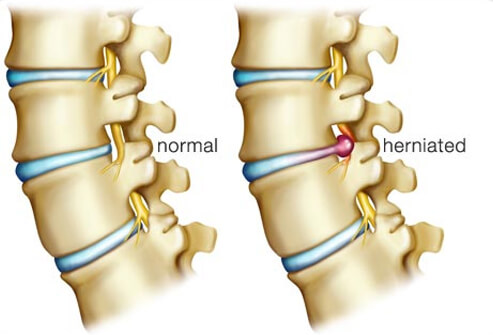
Intervertebral disc is a soft cartilage like structure in our back bone. it lies between two adjacent bones of the back (vertebrae). It has two layers or rings: an outer layer called annulus and an inner layer called nucleus. The weakening of the outer ring of the disc allows the inner layer to bulge through the outer ring and is known as slipped disc. It is also known as spinal disc herniation. Wear and tear of day to day life is the common cause leading to weakening of the disc first. This predisposes the disc to slip out and come in contact with nerve or put pressure on them.
Slipped disc is caused by various factors such as aging, obesity, abrupt injury or accident, prolonged sitting, wrong lifting of objects, squatting, improper movements, degenerative disc disease, long and continuous driving, etc. Many a times, it is not possible to clearly find out the cause of slip disc.
Slip Disc can occur in the lower back or neck region.
Most of the times, slip disc patients improve by themselves and need only supportive care during the process of natural healing. Such supportive care is provided in the form of short course of pain medication, short periods of rest, physical therapy and rehabilitation exercises. Proper education is given to people to improve their posture. With proper exercising schedule, one can prevent the occurrence of slipped disc and other back injuries. Mostly slip disc and back pain patients can be treated without surgery. Slip Disc and Back pain patients can be cured pretty well with exercises and rehabilitation.
Treatment of slip disc without surgery is also possible, therefore, muscle relaxants, medications and pain relievers are given by the doctor to patients to get them better from slipped disc. Spinal Injections and physical therapy are also beneficial in treating herniated disc.
Quitting Smoking and moderation in alcohol intake besides controlling body weight to within 10% of ideal body weight, can help avoid spinal problems.
About 10-15% of slip disc patients may need treatment by surgery. Surgery for back pain and slip disc patients is very safe these days. There is less than 1-2% risk of problems with surgery. Modern Spine surgeries are safe to the extent of 98-99%.
Endoscopic Spine Surgery for Slip Disc is the most advanced and patient friendly technique that helps slip disc patients recover from their problem very quickly, effectively and safely. It is recommended by the slip disc specialist. Many of these endoscopic surgeries are done through small keyhole incisions (8mm) in the patient’s back. they can be done with the patient being awake during the surgery (local anesthesia) or under general anesthesia (Full Endoscopic discectomy). In these techniques, the spine surgeon, creates a small hole in the patient’s back while checking it under x-rays. Then the surgeon will introduce a small 8mm tube in the patient’s spine, protecting the spinal cord and nerves. After that, the slipped portion of the disc that puts pressure on the spinal nerves, is removed by watching it constantly under high powered camera and magnification, thus enabling the surgeon to protect the nerves and remove the diseased part. The risk of becoming paralytic with these surgeries is no more there nowadays.
Other techniques to surgically treat these patients are Microscopic Discectomy that is done under general anesthesia. The surgeon creates a small 1 inch incision in the patient’s back and cuts through various layers of the tissues in the patient’s back. Then a magnifying microscope is brought in and the nerves are protected under magnification to safely remove the slipped disc. Most of the patients of slip disc can be managed surgically by these two methods.
The previous techniques of open spine surgery and laminectomy or spinal fusions are hardly indicated nowadays to treat slip disc patients, but a very small percentage of cases may stil need such treatment.
Minimally Invasive Spine Surgery using keyhole methods and endoscopes allow a very quick return to functional status of the patients and there is hardly any significant postoperative pain due to small size of incision and no damage to other normal structures in the back. These techniques serve as revolutionary treatment for the surgical care of spine patients.
- Pain in one or both legs/arms
- Pain in neck and lower back
- Tingling sensation in affected area
- Numbness and heaviness in legs
- Difficulty in walking
- Prolonged sitting and standing aggravates pain
Dr Arun Bhanot, is one of the best spine doctors and a leading expert at the national and international level in the field of Endoscopic Spine Surgery. He, being the best doctor for slip disc, provides the best advice and surgical treatment for slip disc patients and spinal stenosis patients. Contact him for the best slip disc treatment.
